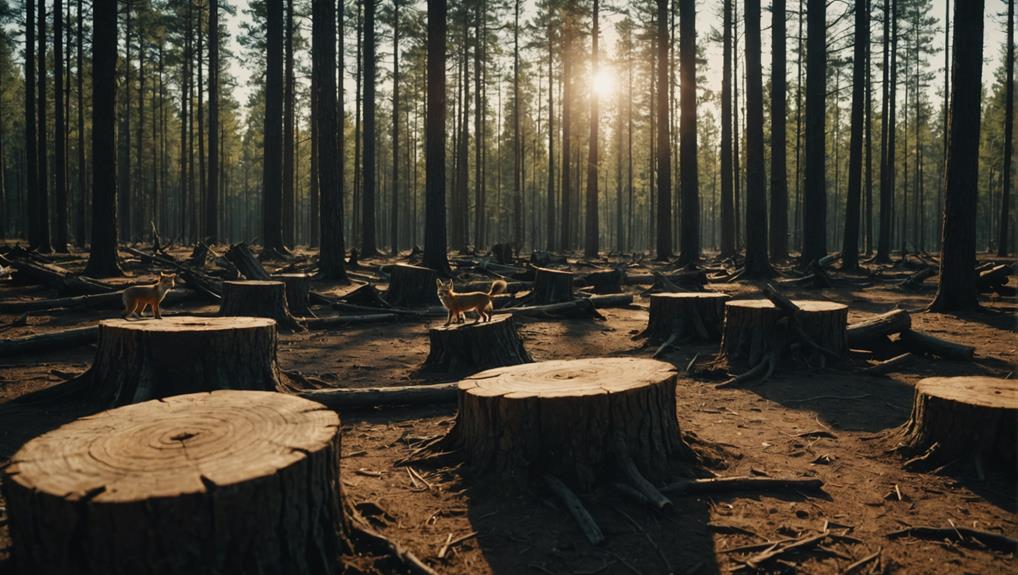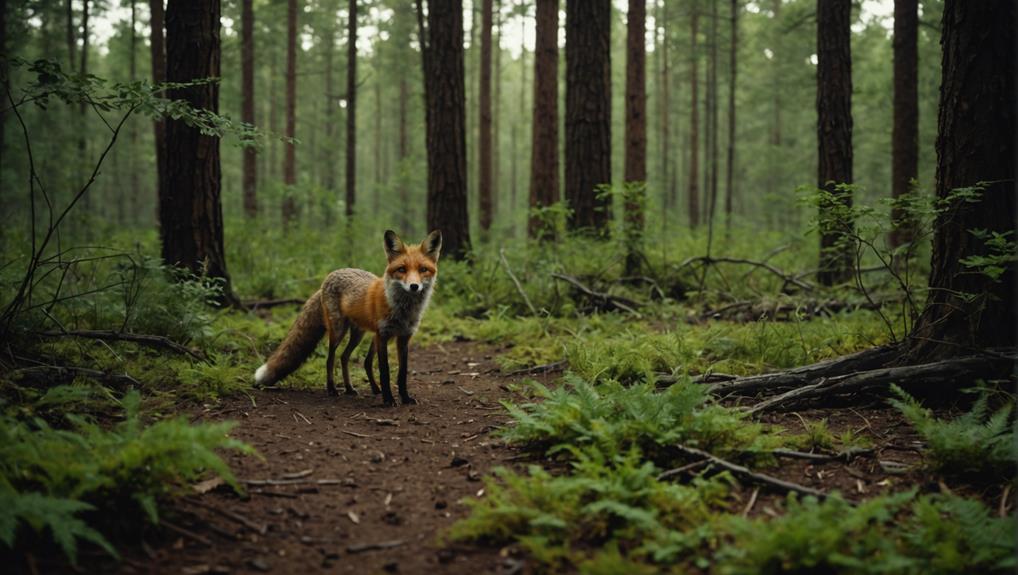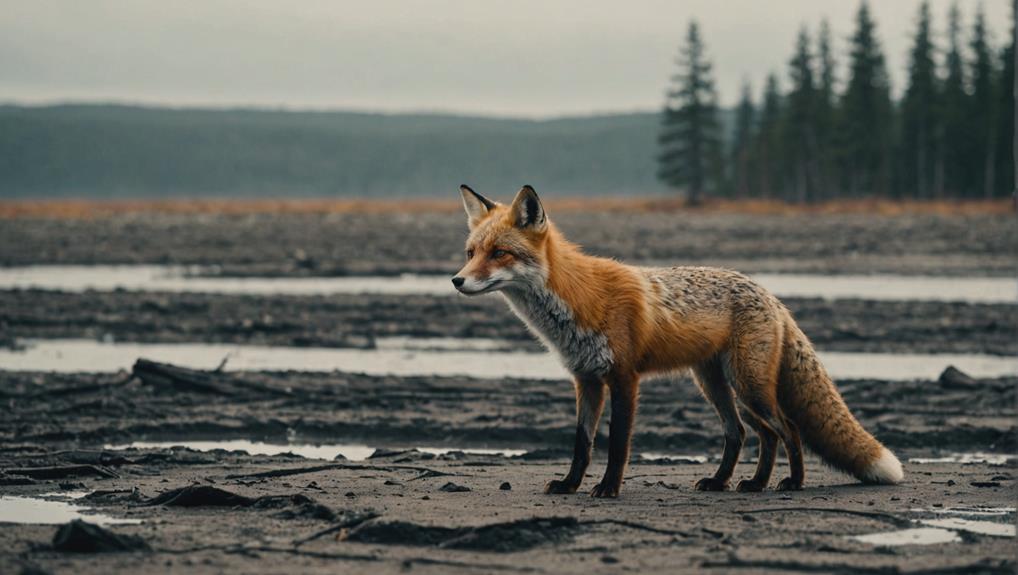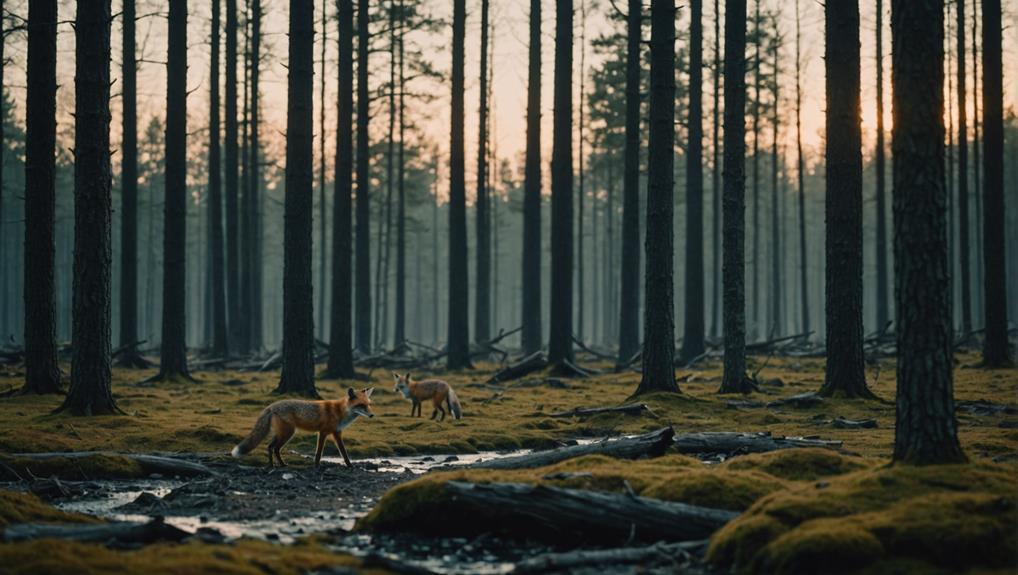Climate change is really shaking up fox habitats, making life a bit tougher for our furry friends. As temperatures rise and weather patterns shift, these clever critters face habitat loss and tougher hunting conditions. Arctic foxes, for instance, are losing their sea ice homes, while red foxes are moving into their territories, leading to fierce competition over limited food resources. Plus, habitat fragmentation makes it harder for them to move and mate. But not all's lost there; conservation efforts are popping up to help! Interested in how these efforts could make a difference? There's plenty more to discover!
Contents
Understanding Fox Habitats
Understanding fox habitats is essential to grasping how climate change impacts these species. When you look at the habitats of foxes like the Arctic and Sierra Nevada red fox, you'll see they thrive in unique environments. The Arctic fox enjoys the tundra, while the Sierra Nevada red fox prefers high-elevation forests and meadows.
Both foxes depend on these spaces for food and shelter, but climate change is squeezing them out. As warming temperatures lead to habitat loss and fragmentation, the delicate balance of their ecosystems is increasingly disrupted, affecting their survival and reproduction.
This is particularly evident in Arctic foxes, which face competition with larger predators as their habitats shrink and prey availability fluctuates key predators' role. As temperatures rise, their habitats shrink, pushing them to higher altitudes and leaving them with fewer places to roam.
Urbanization and farming also break up their homes, making it harder for them to move around and find mates. Imagine trying to make friends at a party where the room keeps getting smaller—it's tough!
Plus, as their specialized habitats become less welcoming, their diets and breeding success take a hit due to changing prey availability. So, next time you spot a fox, remember it's not just a cute animal; it's a symbol of the delicate balance in our ecosystems that we need to protect.
The Effects of Temperature Changes
Temperature changes are dramatically reshaping the habitats of foxes, particularly in the Arctic. As global temperatures rise due to climate change, you'll notice how these changes affect not just the environment, but the lives of our furry friends.
The Arctic fox, for instance, faces fierce competition from the expanding population of red foxes. With winter temperatures climbing by 2-3°C over the last 50 years, the delicate balance of their ecosystem is disrupted.
Moreover, the loss of sea ice impacts the availability of prey, making it harder for Arctic foxes to hunt effectively. Their key adaptations for survival are being put to the test as they navigate these environmental shifts.
Warmer winters bring about unexpected challenges. Droughts and altered precipitation patterns can harm the tundra that Arctic foxes rely on for food. Plus, shrinking sea ice makes hunting even tougher, limiting their foraging opportunities. Imagine trying to catch dinner when your favorite spots are disappearing!
And if that wasn't enough, extreme temperatures can even mess with the breeding cycles of these adorable foxes. With a decline in reproductive success, their populations might struggle to maintain themselves.
To top it off, rising mercury levels in their food due to climate-induced changes can pose serious health risks. It's a tough world out there, and these little foxes need all the help we can give!
Habitat Disruption and Fox Populations

As you think about the impact of climate change on fox populations, consider how habitat disruption is causing serious challenges for these clever creatures.
The changing climate alters ecosystems, affecting food availability and suitable nesting sites for foxes like the Red Fox, which relies on diverse habitats.
When their homes are fragmented, it not only makes finding food and mates tougher, but it also opens the door for invasive species to swoop in and steal their spotlight—talk about a tough crowd!
With all these changes, it's no wonder that foxes are feeling the heat, literally and figuratively, as they try to navigate their shrinking world.
Habitat Fragmentation Effects
Habitat fragmentation wreaks havoc on red fox populations, severely limiting their ability to move freely across landscapes.
Think about it—when their homes are chopped up by urbanization, agriculture, or deforestation, these clever creatures face big challenges. They can't roam around like they used to, which means they struggle to find food and nesting sites. This can lead to fewer adorable fox kits, and who doesn't love those fluffy little faces?
Moreover, with fragmented habitats, red foxes lose genetic diversity. This is a problem because less diversity makes them more vulnerable to extinction. Just look at Henan Province in China, where red fox numbers have plummeted due to habitat loss.
As if that weren't enough, the climate change rollercoaster only makes things worse. With shifting ecosystems, foxes are forced to adapt to new, often less friendly environments.
Competition With Invasive Species
Urbanization and habitat fragmentation aren't the only threats to red fox populations; the rise of invasive species plays a significant role in their survival challenges.
As the weather warms, red foxes are moving north into the tundra, where Arctic foxes have called home for ages. This shift means more competition for food, which isn't great for the Arctic foxes.
You see, they thrive in those chilly habitats, but the newcomers disrupt their delicate balance.
In areas where red foxes invade, studies show they often dominate the shared resources. This means Arctic foxes are at risk of losing out on their primary food sources, like rodents.
It's a bit like being at a buffet and suddenly finding the table filled with sneaky red foxes grabbing all the goodies!
Even worse, the arrival of these invaders brings new diseases that can hit the already vulnerable Arctic fox populations hard.
Species Adaptation to Changing Climates
Adaptability is key for fox species facing the challenges of climate change. As the climate warms, both red and Arctic foxes must navigate new hurdles to survive. You might be surprised at how these clever creatures adjust their behaviors to cope with shifting environments. Here are three ways they do it:
- Foraging Strategies: Red foxes have changed their hunting approaches, becoming more nocturnal to find food when competition is lower.
- Reproductive Changes: Both species are adapting their breeding habits to align with changing seasons, guaranteeing their young have the best chance of survival.
- Dietary Flexibility: With food becoming scarcer, foxes are diversifying their diets, munching on whatever's available, from small mammals to more unusual snacks.
These adaptations are essential, especially for the Arctic fox, which faces heightened competition from red foxes moving into its territory.
Climate change may be tough, but it's impressive to see how these resilient species can adapt and thrive.
By understanding their struggles, we can better support efforts to protect their habitats and guarantee a balanced ecosystem.
After all, every little bit helps, right?
Ecological Impact on Fox Habitats

As fox species adapt to changing climates, the ecological consequences of these shifts are becoming increasingly evident. Take the arctic fox, for example. With rising temperatures and shrinking snow cover, these clever creatures are forced to migrate to higher elevations in search of suitable habitats. This isn't just a little inconvenience; it disrupts their entire way of life!
You see, as arctic foxes move, they face increased competition from red fox populations that are spreading due to warmer conditions. It's like an unexpected family reunion where everyone's fighting for the same snacks! Additionally, altered precipitation patterns and warmer winters are making tundra ecosystems less hospitable. With fewer prey options available, arctic foxes find themselves in a tough spot.
Oh, and let's not forget about melting sea ice! This change makes foraging nearly impossible at times, compounding the ecological impact on their already shrinking habitats.
Sadly, the rapid pace of climate change is making it even harder for arctic foxes to thrive, as they deal with rising disease risks and reduced genetic diversity.
Conservation Efforts for Fox Species
When it comes to conserving fox species, there's a lot you can get involved in, from habitat restoration initiatives to community engagement strategies.
You'd be surprised how easy it's to help monitor their population health, making sure these clever critters have a fighting chance.
Habitat Restoration Initiatives
Habitat restoration initiatives play an essential role in conserving the Sierra Nevada red fox, a species threatened by habitat loss from logging and recreation. These projects are essential for creating and maintaining environments that support these rare foxes.
Here are three key efforts you might find inspiring:
- Reforestation: Planting trees to replace those lost helps restore the fox's home and improves air quality.
- Invasive species management: By controlling non-native plants and animals, we can give native species, including the fox, a fighting chance.
- Protected areas: Establishing safe zones guarantees connectivity between fox populations, making it easier for them to thrive.
You can see how these strategies not only combat climate change but also foster a healthier ecosystem. Collaborating with local communities and conservation organizations makes these efforts even more effective, blending modern science with traditional ecological knowledge.
It's like having your cake and eating it too! Monitoring these projects helps us track progress and adjust as needed, assuring that our furry friends have a fighting chance.
Increased funding through donations is essential, so every little bit helps in safeguarding the long-term survival of these charming creatures.
Together, we can make a difference!
Community Engagement Strategies
Community involvement is essential for the conservation of endangered fox species. By engaging local communities, you can greatly enhance awareness and boost the effectiveness of conservation initiatives.
Imagine hosting an event where neighbors learn about fox behaviors and their roles in the ecosystem. This kind of educational campaign can foster empathy and understanding, making people more mindful of their interactions with wildlife.
You might also consider becoming a citizen scientist! Tracking fox populations or collecting data can empower you and your friends while contributing to valuable conservation research.
Plus, partnering with schools and organizations can help spread the word, teaching both kids and adults about the importance of conserving fox habitats, especially in the face of climate change.
Don't underestimate the power of social media, either. Platforms like Facebook or Instagram can be excellent tools for raising awareness about the threats foxes face.
Sharing stories and organizing fundraising events can rally support from your community. Remember, when you get involved, you're not just helping foxes; you're creating a stronger, more connected community that cares for its local wildlife.
Let's work together to guarantee a bright future for these incredible creatures!
Monitoring Population Health
Monitoring the health of fox populations is vital for effective conservation efforts. By keeping an eye on these clever canines, we can guarantee they thrive in our changing world. Here are three key ways we track their well-being:
- Satellite Collars: These nifty devices help researchers understand habitat use and movement patterns, giving us a glimpse into their daily lives.
- Surveys on Fox Dens: By visiting over 115 active sites, scientists gather demographic and health data. It's like a health check-up for our furry friends!
- Collaboration with Trappers: Teaming up with local trappers helps us collect data on carcasses and diet. This info reveals trends in food availability and health concerns.
Moreover, monitoring population health includes evaluating contaminant levels like mercury. It's essential to know how environmental changes impact their health and diets.
Plus, understanding fluctuations in small mammals, like rodents, directly affects fox survival rates.
Future Challenges for Fox Habitats

As climate change continues to reshape ecosystems, fox populations face a myriad of future challenges that directly threaten their survival. For instance, arctic foxes are being pushed to migrate to higher elevations in the Sierra Nevada.
While they might think it's a cozy getaway, it's actually making life tougher. They encounter increased competition for resources as they share their new digs with other species.
Rising temperatures and changing weather patterns are fragmenting their habitats, making it harder for them to move around and mingle with other foxes. You can imagine how frustrating that is—like trying to make friends at a party where everyone's scattered!
Plus, invasive red foxes are muscling in, causing more trouble for local arctic fox populations.
Extreme weather events, like unpredictable snowmelt and droughts, mean food is getting harder to find. This decline in prey not only makes mealtime a challenge but also affects reproduction and survival rates.
Final Thoughts
So, as you can see, climate change is shaking up the homes of foxes in some pretty serious ways. Did you know that in just the past few decades, fox populations have dropped by nearly 30% in certain areas? That's a big deal! But don't lose hope. With smart conservation efforts and a little help from all of us, we can still make a difference. Let's work together to guarantee these clever critters have a bright future!














